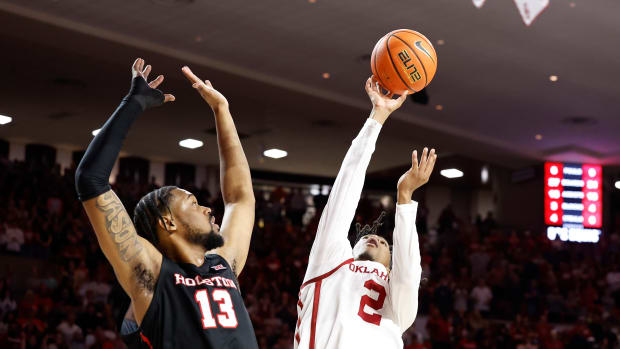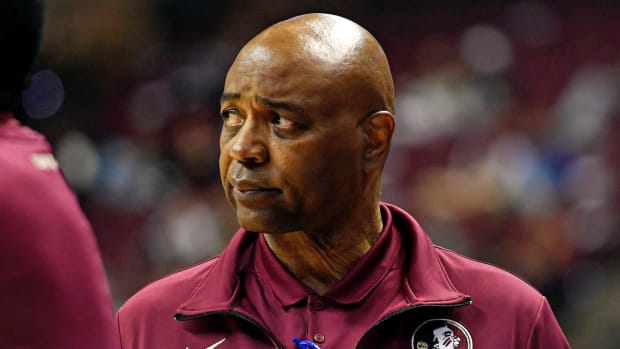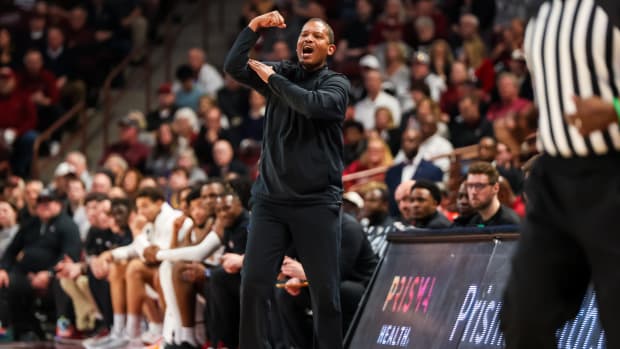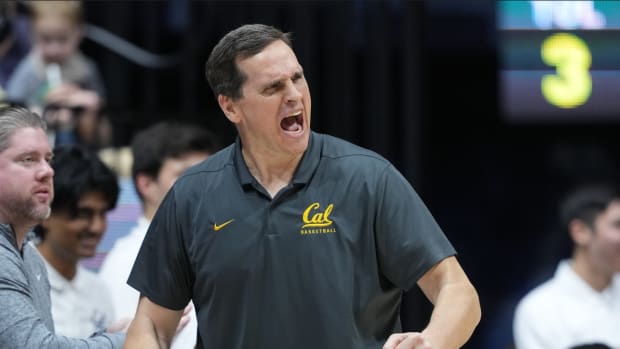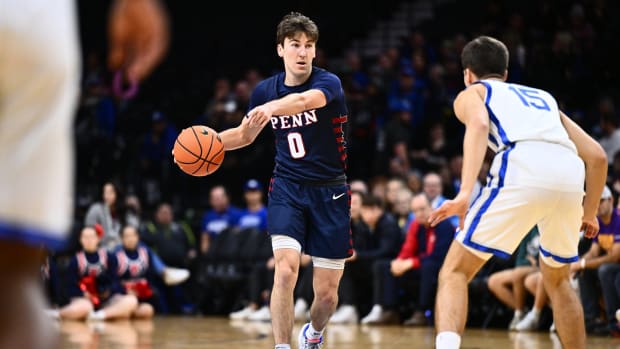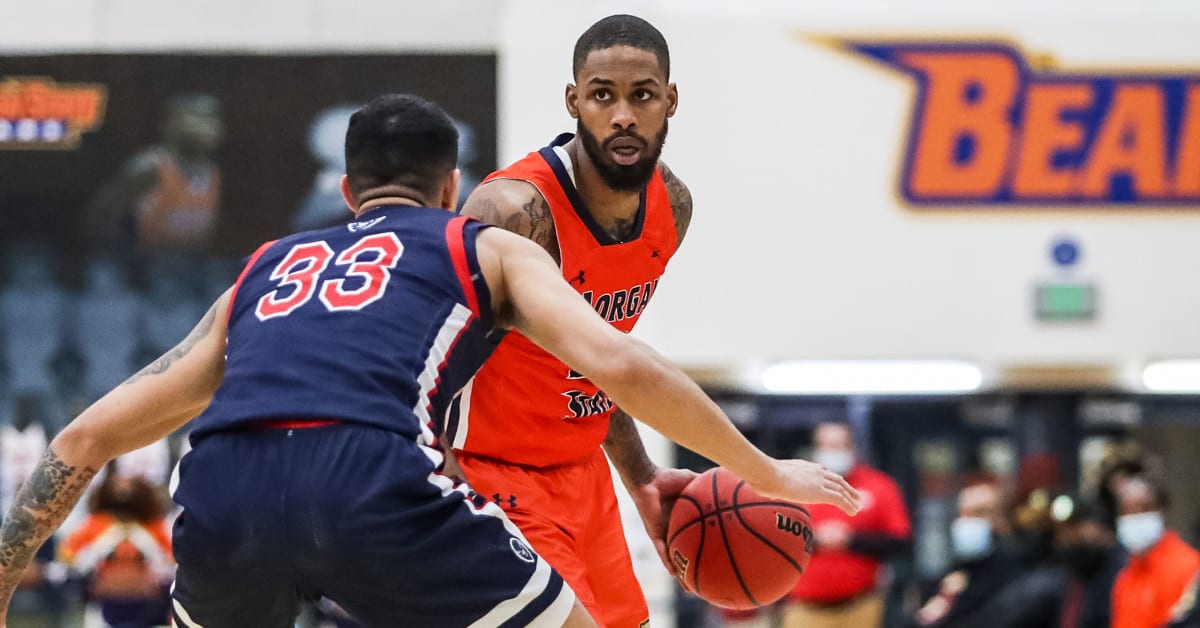
A Mixtape Changed Seventh Woods’s Life at 14. Years Later, He’s Picking Up the Pieces.
Morgan State University is just five miles east of M&T Bank Stadium, where more than 70,000 of the rowdiest fans in the NFL convene on Sundays to passionately cheer on Lamar Jackson and the Ravens. But for Seventh Woods, it might as well be on a secluded island.
He walks into the plush new student center, black hoodie pulled snuggly over his black KN95 mask as he beelines through a sea of people toward the Chick-fil-A line.
No one shoots a that’s him! point, stops him for a selfie or even flashes an excited grin. Aside from sparsely placed head nods, no one bothers Woods at all. It’s a scenario he’s chased for nearly nine years.
“Things are a lot different for me now,” he says. “And, man, I love that!”
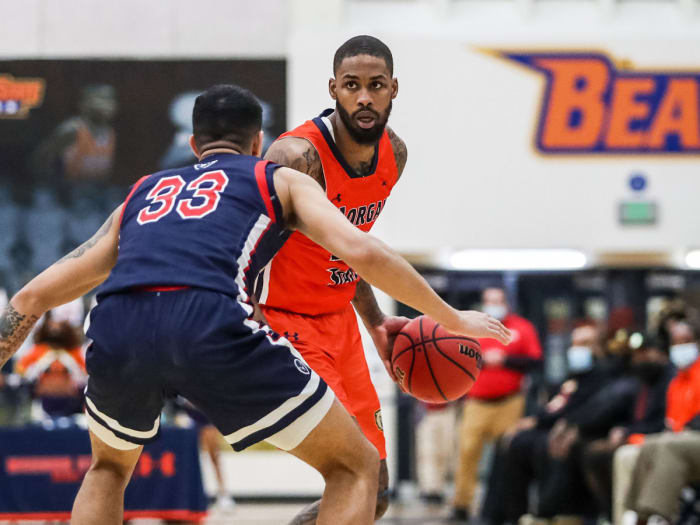
Morgan State is Woods’s third collegiate stop, after North Carolina and South Carolina.
Courtesy of Morgan State
Woods’s normal, serene life as a 23-year-old graduate transfer for the Bears is a stark contrast from his roller-coaster ride of a freshman year at North Carolina in 2016 and even as a freshman at Hammond School (Columbia, S.C.), when a two-minute, 36-second highlight video clip served as the fuel for the hype train that would ultimately change his life.
Like most young hoopers on the come-up, Woods religiously scoured YouTube in his preteen years for the next big high school basketball star’s poster-dunk-filled reels. From John Wall to Aquille Carr to Ryan Harrow, high school prospects were immediately elevating from elite to rockstar based on three-minute clips zeroing in on the high points from a season.
“I remember I used to watch John Wall’s mixtape and Aquille Carr’s,” Woods says. “Man! That was everything. I used to want the HoopMixTape shirt and everything. Before you knew it, they were showing up at my games.”
In 2013, the summer before Woods’s freshman year at Hammond, Nils Wagner, founder of HoopMixTape.com, came across a clip of Woods breaking a full-court press using his speed and instincts. Instant intrigue prompted him to search further, yielding just one clip of a moderately impressive dunk on the break from when he was 13.
“I just had a feeling that he was gonna be big,” Wagner says. “My thing was I really wanted to break someone that the country didn’t know about.”
As a major player in the video highlight space, Wagner knew his presence at a private school in rural South Carolina would draw attention, so he sent a videographer on an eight-hour one-way drive to film Woods’s next game.
“I said, ‘Dude, if the kid doesn’t score 30 points, you never have to film him again,’” Wagner says. “But I could tell he had something special. He ended up scoring 40 and had five crazy dunks. We quietly filmed his whole freshman season after that.”
In 2014, HoopMixTape released the video of Woods’s freshman season with the Skyhawks, displaying the 6'2" guard’s mind-boggling speed and athletic ability in the form of 32 pandemonium-ensuing dunks.
As far as hoops highlight mixtapes go, Woods is firmly sculpted on the Mount Rushmore. It’s garnered more than 16.2 million views to date, the most-viewed high school hoops highlight mixtape of all time.
“I remember being so happy when it came out,” Woods says. “I had no idea how big it was gonna get. It makes me sound old, but I wasn’t thinking about going viral back then. That wasn’t a thing. I just know that the next game was sold out with fire marshals and everything. I never had a game that wasn’t sold out after that.”
And to the viral victor came all the spoils.
From guest spot invitations on The Ellen DeGeneres Show and Jimmy Kimmel Live! to commercials, Woods’s parents, Louis and Monica, kept a full voicemail box. Shortly after the video broke, Under Armour even became the official sponsor for Hammond.
That type of impact in today’s climate would likely have put millions on the table for Woods, even as an underclassman, with endorsement deals and pro options galore. Mikey Williams, a junior guard at Vertical Academy in Charlotte, is the modern-day Seventh Woods. Williams is the most popular high school athlete in the country with an Instagram following that eclipses 3.6 million and friends like Drake and Da Baby, as well as NBA superstars like LeBron James and Kawhi Leonard.
In July, Williams inked a deal with Excel Sports Management, becoming the first high school basketball star to sign with a major sports agency to pursue name, image and likeness endorsements. In November, he inked a multiyear deal with Puma, making him the first U.S. high school basketball player to sign a sneaker deal with a global footwear company.
It was all sparked by a viral highlight clip when he was 14. Sound familiar?
“We kinda wanted to shield him from all of that extra attention,” Monica says of Woods. “At the time, we just thought it would be too much for a kid his age. When you think back now, though, there was no way to stop it.”
As a teenager, Woods was instantly labeled the heir apparent, drawing comparisons to everyone from Russell Westbrook to Derrick Rose. The problem there was twofold: Woods, at the ripe age of 14, wasn’t an NBA superstar, and the public didn’t care.
The proverbial gift and the curse of attention produced a magnifying glass that he couldn’t shake with even his best crossover. It created a dark cloud of doubt in his head that loomed for years.
“I thought I had to be perfect; I really did,” Woods says. “If I got a turnover, all I could think was that people were gonna think I wasn’t that good. I really questioned every mistake. In hindsight, I was trying to live up to people’s expectations and I couldn’t shake that.”
Wagner noticed the change during his sophomore high school season. Woods took fewer chances, was less aggressive and didn’t play with the same reckless abandonment that ultimately made him special.
“You could see him second-guessing himself,” Wagner says. “It was night-and-day different. It all just seemed like too much for him. You could see it was affecting his game. I filmed his whole sophomore season, had the highlight video done and everything, but I just couldn’t put it out because I could see how the extra attention was affecting his game. It didn’t feel right. I literally still have the highlight video. Never put it out.”
Woods finished high school in a weird mental space; the valleys of self-doubt following bad games were remedied with peaks of 30-point outbursts, giving him the reassurance he so desperately needed.
But when he went to North Carolina in 2016 to join a team fresh off a heartbreaking loss at the buzzer to Villanova in the national title game, he had more expectations and fewer opportunities. Even as a freshman averaging seven minutes a game, to the masses, Woods was arguably the most famous player on the team.
In the freshman’s eyes, every random yelling of his name when he’d be out and about, every autograph request and every picture he took only meant those fans required greatness. The pressure caused him to live in his head constantly while competing—the most potent form of kryptonite for production on the hardwood.
“I knew I’d have to backup Joel [Berry] and I was cool with that,” Woods says. “We won the national title that first year, but then he ended up staying another year. That kinda pushed my playing time back a little bit. At North Carolina, they built a culture where you have to buy in.
“When you play behind a guy like Joel, who’s really good and already established, you always have a short leash, so you become robotic and try to do exactly what Coach asks. You’re not yourself because if you mess up being yourself then you feel like you’re done. That was my problem.”
Unlike high school, Woods wasn’t able to pull himself out of his head with good games and wow plays, which caused consistent blows to his mental health, culminating in a call to his parents telling them he “was done” following a lackluster game against North Carolina State. “It was during my sophomore year; I played bad and it hit me hard,” he says. “I had never felt that way before and I definitely had never said that before. It was a lot to handle for me.”
Finally, the summer after his sophomore year, Woods underwent counseling at the university, fighting his natural inclination to internalize things and “just play through it.” “It was helpful; very helpful,” he says. “I had a really good relationship with my counselor, and there was a lot of trust there. Once the games were over, on campus I tried to just be a regular student. I tried to be someone other than a basketball player so I wouldn’t think about what other people would think.”
After a junior season when he averaged 10.8 minutes and 2.5 points a game, Woods decided to transfer back home to South Carolina. NCAA transfer rules forced him to sit for the 2019–20 season, which meant he’d have to start with the Gamecocks during the unorthodox pandemic season.
“You can’t make this stuff up,” says Woods, who averaged 5.4 points and 19 minutes a game at South Carolina. “I never got the full experience there and there were, obviously, a lot of starts and stops because of COVID. I just couldn’t get into a rhythm.”
Woods had nagging knee and back injuries over the years, but the mental price was the steepest. It created one player in practice and open gym who looked like a mature version of that viral kid from the HoopMixTape video and another player in the game who overthought everything and underperformed as a result.
With another year of eligibility, he could’ve returned to the Gamecocks this season, but he wanted a fresh start. He wanted to get away from the place where this all started and shake off the stench of the powder-blue debacle. He wanted to be at a place where he could be, well, regular.
“I wanted to be off the radar,” Woods says. “That was definitely part of it.”
Morgan State head coach Kevin Broadus had formed a bond with Woods while he was an assistant at Georgetown and was the first coach to reach out to when Woods announced his transfer from South Carolina. Broadus’s take on the player’s trajectory has always been more about the fit and less about his abilities.
“If he would’ve come to Georgetown, he would’ve changed the program back to being where we were at the height,” Broadus says. “He’s really that good. I think if we would’ve gotten Seventh Woods, John Thompson III would still be the coach at Georgetown, and I would still be the assistant at Georgetown because we would’ve won.”
When Woods decided to join the Bears, his father Louis called Broadus with a message that was as simple as it was profound: “Let him be normal.”
“He wasn’t coming to save the day,” Louis says. “I just wanted him to go somewhere that he could play and get better. I just wanted him to be happy again.”
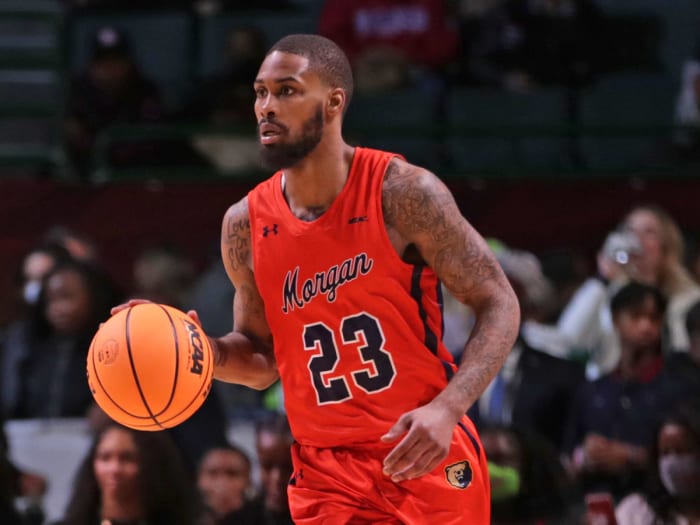
Woods isn’t giving up on his professional dream as he wraps his college career.
Courtesy of Morgan State
This isn’t the part of the story where the dramatic music begins to play over images of Woods transforming back into his once-dominant self, rocking rims and taking names en route to leading Morgan State to the top of the MEAC.
The reality is more bleak: The Bears sit at 11–13, fifth in the league, and Woods is posting a modest 5.4 points, 2.1 rebounds and 2.4 assists. The bigger win for Woods this season has been upstairs. Little by little, he’s delivering consistent, tangible on-court evidence to show and prove to himself while remaining resolute in the inevitable valleys.
“I wouldn’t trade having Seventh for anything,” Broadus says. “His leadership and experience have been special. Forget the stats; he’s been a special person. The injuries and the experiences have been rough and he’s still here. He’s still fighting. Most people would’ve quit a long time ago, but him staying in the fight is why I know he’ll make it.”
It helps that Woods still remembers when basketball was very much black and white to him—when it was about instinct over anxiety. Defender pressing up too close? Dart by him, and if the defense converges when you get a piece of the paint, kick out for a three-pointer. If not, posterize whoever dares to jump. Simple.
The last nine years, though, have made the game more gray. His move to Morgan State was about simplicity and normalcy as he grasps for the black and white. “It’s still a battle,” Woods says. “It’s not just hard to get out of your head, it can seem like it’s impossible. I do feel like it’s better, but I’m still working on it. I’m happier now; happier than I’ve been in a long time.”
Woods’s motivation is rooted in the belief that he’ll still be able to realize his dream of playing professionally, though he’s not unrealistic about the difficulty of reaching that goal. “That’s still my plan A,” he says. “I don’t have a plan B because I’m focused on that. I know my road could be different, but I’m putting everything into pursuing my dreams because that’s what will make me happy. No excuses.”
There are, however, questions. And there’s one in particular he has yet to answer even nine years later: Does he wish his HoopMixTape video would’ve never dropped?
Woods pauses to ponder then says, “Hmm” before pausing again.
“It’s hard to say,” he continues. “I don’t know how to answer that question. I just wish it wouldn’t have come with all the bad. I know that’s not realistic, though. I’ll say this: I feel like whenever I get to where I’m supposed to go, I’ll look back on this whole process and understand why it all happened the way it did.”
More College Basketball Coverage:
• Dan and Bob: A Basketball Bromance
• After Rash of Upsets, Is Pool of Contenders Expanding?
• Dickie V Can’t Be Silenced




